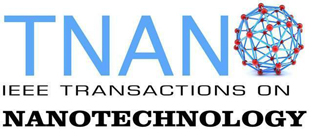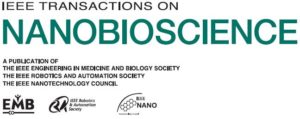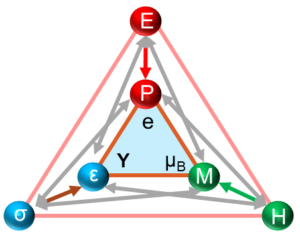Publications
NTC has several publications and an e-newsletter
Guidelines for Artificial Intelligence (AI)-Generated Text
The use of artificial intelligence (AI)–generated text in an article shall be disclosed in the acknowledgements section of any paper submitted to an IEEE Conference or Periodical. The sections of the paper that use AI-generated text shall have a citation to the AI system used to generate the text.
IEEE Transactions on Nanotechnology (T-NANO)
Editor-in-Chief: Sorin Cotofana
 T-NANO is a peer-reviewed hybrid journal, and publishes novel and important results in engineering at the nanoscale. The scope of TNANO includes the physical basis and engineering applications of phenomena at the nanoscale level across all areas of science and engineering. TNANO publishes Regular Papers and Letters. It focuses on nanoscale components, systems, materials and applications, and on their underlying science.
T-NANO is a peer-reviewed hybrid journal, and publishes novel and important results in engineering at the nanoscale. The scope of TNANO includes the physical basis and engineering applications of phenomena at the nanoscale level across all areas of science and engineering. TNANO publishes Regular Papers and Letters. It focuses on nanoscale components, systems, materials and applications, and on their underlying science.
TNANO is an online publication with accepted papers published on the web as soon as they are submitted in final form. Web-published papers have a DOI (Digital Object Identifier), and are fully citable and downloadable.
Nanotechnology is evolving rapidly and swift publication is necessary to ensure that authors submit their best work to the Transactions. Fast publication is achieved through TNANO’s entirely electronic submission and review process.
Visit the TNANO website for information on the editorial board, special issues, and how to get your contribution published.
View the top interest articles here.
“Letters” in TNANO
Associate Editor-in-Chief: Prof. Gwo-Bin Lee
The “Letters” in TNANO serves as forum for rapid publication of high-quality articles – featuring the topics of great current interest in all areas of nanotechnology, including nanoscale materials, devices, systems, and applications, and their underlying science, which cover the interdisciplinary and multidisciplinary areas across engineering, material science, physics, chemistry, biology, medicine, and related disciplines.
The “Letters” category publishes a collection of peer-reviewed short reports of original research and perspectives and mini-reviews on emerging topics. Papers submitted to the “Letters” are limited to a maximum of 4 journal pages in the two-column IEEE format, which includes figures, tables, and references. The “Letters” in TNANO maintains the same competitive and constructive peer-review criteria of TNANO with no article publishing charges.
![]() IEEE Open Journal of Nanotechnology (OJ-NANO)
IEEE Open Journal of Nanotechnology (OJ-NANO)
Editor-in-Chief: Wen Jung Li; Associate-Editor-in-Chiefs: Jin-Woo Kim & Seiji Samukawa
 The IEEE Open Journal of Nanotechnology (OJ-NANO) covers the theory, design, and development of nanotechnology and its scientific, engineering, and industrial applications.
The IEEE Open Journal of Nanotechnology (OJ-NANO) covers the theory, design, and development of nanotechnology and its scientific, engineering, and industrial applications.
The OJ-NANO publishes novel and important engineering and scientific results at the nanoscale. Research results related to nanoscale devices, systems, materials and applications, and on their underlying science are considered for peer-review and publication in this journal. Accepted papers are published on the web (IEEE Xplore) as soon as they are submitted in approved IEEE format. Web-published papers have a DOI (Digital Object Identifier), and are fully citable and downloadable. Nanotechnology is evolving rapidly and swift publication is necessary to ensure that authors submit their best work to the OJ-NANO. Fast publication is achieved through OJ-NANO’s entirely electronic submission and review process.
Examples of research results covered by OJ-NANO are: (1) nano and molecular electronics, (2) nano and molecular circuits and architectures, (3) nanomagnetism and spintronics, (4) nanooptics, nanooptoelectronics and nanophotonics, (5) nanorobotics and nanoassembly, (6) nanosensors and nanoactuators, (7) nanomechanics and NEMS (nanoelectromechanical systems), (8) nanobiotechnology aand nanomedicine, (9) nanofabrication and nanolithography, (10) nanometrology and characterization, (11) computational nanotechnology, (12) nanomaterials for flexible sensors and electronics, and (13) applications of NEMS/nano sensors in AI, robotics, and healthcare. In addition, papers in other areas, especially new or emerging areas, are also welcome.
Visit the OJ-NANO website for information on the editorial board, special issues, and how to get your contribution published.
View the top interest articles here.
IEEE Nanotechnology Magazine (INM)
Editor-in-Chief: Bing Sheu
 The IEEE Nanotechnology Magazine publishes peer-reviewed articles that present emerging trends and practices in industrial electronics product research and development, key insights, and tutorial surveys in the field of interest to the member societies of the IEEE Nanotechnology Council. INM will be limited to the scope of the Nanotechnology Council, which supports the theory, design, and development of nanotechnology and its scientific, engineering, and industrial applications.
The IEEE Nanotechnology Magazine publishes peer-reviewed articles that present emerging trends and practices in industrial electronics product research and development, key insights, and tutorial surveys in the field of interest to the member societies of the IEEE Nanotechnology Council. INM will be limited to the scope of the Nanotechnology Council, which supports the theory, design, and development of nanotechnology and its scientific, engineering, and industrial applications.
Visit the INM website for information on the editorial board, special issues, and how to get your contribution published.
View the top interest articles here.
IEEE Nanotechnology Newsletter
Editor-in-Chief: Jr-Hau He
 The IEEE Nanotechnology e-Newsletter provides information on NTC publications, conferences, events, and developments in nanotechnology and applications.
The IEEE Nanotechnology e-Newsletter provides information on NTC publications, conferences, events, and developments in nanotechnology and applications.
IEEE Transactions on NanoBioscience (T-NB)
Editor-in-Chief: Dan Nicolau
 The IEEE Transactions on NanoBioscience reports on original, innovative, and interdisciplinary research, both fundamental and applied, focusing on nano- to micro-scale biological systems. The journal invites contributions describing advances in bio-science, -technology, and -engineering, from biomolecular to multi-cellular domains, concerning their physics (e.g., mechanics, materials, electromagnetism); their chemistry (e.g., DNA, proteins, biochemical pathways); or their information storage and processing (e.g., biological signals, algorithms, and computation).
The IEEE Transactions on NanoBioscience reports on original, innovative, and interdisciplinary research, both fundamental and applied, focusing on nano- to micro-scale biological systems. The journal invites contributions describing advances in bio-science, -technology, and -engineering, from biomolecular to multi-cellular domains, concerning their physics (e.g., mechanics, materials, electromagnetism); their chemistry (e.g., DNA, proteins, biochemical pathways); or their information storage and processing (e.g., biological signals, algorithms, and computation).
T-NB is sponsored by the IEEE EMB Society, Nanotechnology Council and RA Society.
Visit the T-NB website for information on the editorial board, special issues, and how to get your contribution published.
View the top interest articles here.
IEEE Journal of Photovoltaics (J-PV)
Editor-in-Chief: Angus Rockett
The IEEE Journal of Photovoltaics is a peer-reviewed, archival publication reporting original and significant research results that advance the field of photovoltaics (PV). The PV field is diverse in its science base ranging from semiconductor and PV device physics to optics and the materials sciences. The journal publishes articles that connect this science base to PV science and technology. The intent is to publish original research results that are of primary interest to the photovoltaic specialist.
The scope of the IEEE J. Photovoltaics incorporates: fundamentals and new concepts of PV conversion, including those based on nanostructured materials, low-dimensional physics, multiple charge generation, up/down converters, thermophotovoltaics, hot-carrier effects, plasmonics, metamorphic materials, luminescent concentrators, and rectennas; Si-based PV, including new cell designs, crystalline and non-crystalline Si, passivation, characterization and Si crystal growth; polycrystalline, amorphous and crystalline thin-film solar cell materials, including PV structures and solar cells based on II-VI, chalcopyrite, Si and other thin film absorbers; III-V PV materials, heterostructures, multijunction devices and concentrator PV; optics for light trapping, reflection control and concentration; organic PV including polymer, hybrid and dye sensitized solar cells; space PV including cell materials and PV devices, defects and reliability, environmental effects and protective materials; PV modeling and characterization methods; and other aspects of PV, including modules, power conditioning, inverters, balance-of-systems components, monitoring, analyses and simulations, and supporting PV module standards and measurements. Tutorial and review papers on these subjects are also published and occasionally special issues are published to treat particular areas in more depth and breadth.
J-PV is jointly sponsored by the IEEE Electron Devices Society, Photonics Society, Power and Energy Society, Power Electronics Society, Industrial Electronics Society, Reliability Society and Nanotechnology Council.
Visit the J-PV website for information on the editorial board, special issues, and how to get your contribution published.
View the top interest articles here.
IEEE Journal on Exploratory Solid State Computational Devices and Circuits (xCDC)
Editor-in-Chief: Azad Naeemi
 IEEE Journal on Exploratory Solid State Computational Devices and Circuits is an open-access online journal focused on multi-disciplinary research in solid-state circuits using exploratory materials and devices for novel energy efficient computation beyond standard CMOS (complementary Metal Oxide Semiconductor) technology. Specifically, the exploration of materials, devices and circuits for computation to enable Moores Law to continue for computation beyond a 10 to 15 year horizon (beyond end of the roadmap for CMOS technologies) with the associated density scaling and improvement in energy efficiency. Published by the IEEE Solid State Circuits Society. Examples of appropriate topics are research milestones in the integration of exploratory materials, devices and computation circuits based upon any of the following:
IEEE Journal on Exploratory Solid State Computational Devices and Circuits is an open-access online journal focused on multi-disciplinary research in solid-state circuits using exploratory materials and devices for novel energy efficient computation beyond standard CMOS (complementary Metal Oxide Semiconductor) technology. Specifically, the exploration of materials, devices and circuits for computation to enable Moores Law to continue for computation beyond a 10 to 15 year horizon (beyond end of the roadmap for CMOS technologies) with the associated density scaling and improvement in energy efficiency. Published by the IEEE Solid State Circuits Society. Examples of appropriate topics are research milestones in the integration of exploratory materials, devices and computation circuits based upon any of the following:
- Quantum electronics (e.g. tunneling),
- Spintronics and nanomagnetics,
- Straintronics (piezo-electric devices),
- Plasmonics,
- Functional materials,
- High fan-in, fan-out logic circuits,
- Reconfigurable and non-volatile computational circuits,
- Computational circuits comprehending the on-chip communication means.
Inquiries for the xCDC Journal should be sent to: JXCDC@IEEE.ORG
Visit the JxCDC website for information on the editorial board, special issues, and how to get your contribution published.
See the latest articles here.
IEEE Transactions on Molecular, Biological, and Multi-Scale Communications (T-MBMC)
Editor-in-Chief: Chan-Byoung Chae
T-MBMSC is devoted to the principles, design, and analysis of communication systems that use physics beyond classical electromagnetism. This includes molecular, quantum, and other physical, chemical and biological techniques; as well as new communication techniques at small scales or across multiple scales (e.g., nano to micro to macro). Original research articles on one or more of the following topics are within scope: mathematical modeling, information/communication and network theoretic analysis, standardization and industrial applications, and analytical or experimental studies on communication processes or networks in biology. Contributions on related topics may also be considered for publication. Contributions from researchers outside the IEEE’s typical audience are encouraged. Published by the IEEE Communications Society.
See the latest articles here.
IEEE Transactions on Multi-Scale Computing Systems (TMSCS)
Ceased publication in 2018.
IEEE Transactions on Multi-Scale Computing Systems (TMSCS) was a selective peer-reviewed publication devoted to computing systems that exploit multi-scale and multi-functionality. These systems consist of computational modules that utilize diverse implementation scales (from micro down to the nano scale) and heterogeneous hardware and software functionalities; moreover, these modules can be based on operating principles and models that are valid within but not necessarily across their respective scales and computational domains. Contributions to TMSCS must address computation of information and data at higher system-levels for processing by digital and emerging domains. These computing systems can also rely on diverse frameworks based on paradigms at molecular, quantum and other physical, chemical and biological levels. Innovative techniques such as inexact computing, management/optimization of smart infrastructures and neuromorphic modules are also considered within scope. Co-published with the Computer Society.
Editors-in-Chiefs
The term of office for all Editors-in-chief of the Council’s periodicals is two years, renewable twice. Upon a vacancy or an expiration of a term, the President may appoint a qualified individual to an Editor‑in‑chief post, with the advice of the Nominations and Appointments and Publications Committees, and with the consent of AdCom. Eligibility for an Editor‑in‑chief post shall be restored after a lapse of two years.

